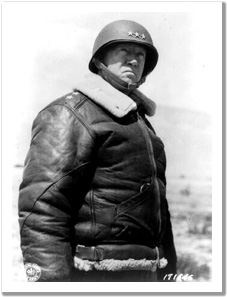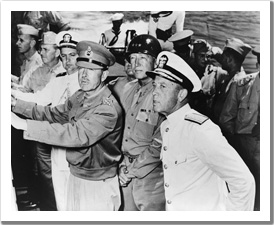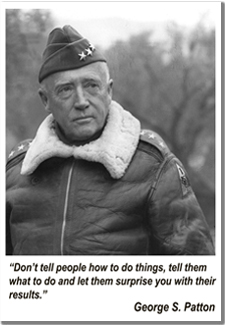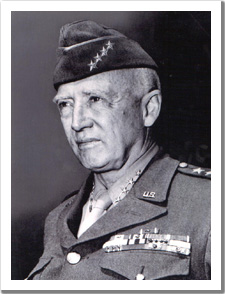General George S. Patton always held a special place in his heart for France. He was raised on stories of Napoleon, spoke French, visited the country as a young officer, perfected his sword fighting abilities there and fought for the country’s freedom twice, during World War I and World War II.
Patton was exposed to the French language as a child, although he did not master it until he was an Army officer. His father had taught French at the Virginia Military Institute in 1877, and young Patton later studied French at the Classical School for Boys in Pasadena, California. As a young student, we wrote essays on battles and included the tales of the Black Knight fighting the Normans.
Patton was exposed to the French language again when he first met his future wife, Beatrice Ayer. He was seventeen and she sixteen, but Patton thought she looked too much like a little girl, always carrying a porcelain doll. What he did not know was that she earned the doll by speaking French exclusively for a week. She had already traveled Europe and parts of the Middle East when they met.
As Patton pursued his career as a soldier, he often compared himself to Napoleon, took lessons from the French commander’s life and analyzed his battles. He once lamented that other cadets did not take him seriously, as opposed to Napoleon, whose classmates looked upon him as a leader of men. Later, he complained in an essay that other cadets did not take the study of military history seriously, even though it was, “as Napoleon says, the only school of war.” Upon graduation, he made a note to himself: “Napoleon never neglected a detail. When he could not win over a man he made it at least appear to others that he had done so. Nothing is too small to win.”
Patton competed in the 1912 Olympics in Stockholm, Sweden, in the Modern Pentathlon, composed of five events: a pistol shoot, the three-hundred-meter swim, fencing, a steeplechase ride and running a two-and-a-half-mile course. He finished fifth out of 42 competitors, but during the fencing competition, he bested a French swordsman, a world class competitor.
Instead of heading home after the games, Patton went to France to improve his fencing abilities under Monsieur l’Adjutant Clery, who was considered one of the best fencers in all of Europe.  Clery taught at the Cavalry School in Saumur, which Patton considered the “nirvana” for all American horse cavalrymen. Patton took private lessons from Clery and also watched as he instructed his cavalrymen—the Black Corps.
Clery taught at the Cavalry School in Saumur, which Patton considered the “nirvana” for all American horse cavalrymen. Patton took private lessons from Clery and also watched as he instructed his cavalrymen—the Black Corps.
Patton returned to Saumur in the summer of 1913 to formerly attend the Cavalry School. Once in France, he and his wife spent a few days in St. Lo, buying furniture. When Patton completed his training he was given the title Master of the Sword. Although only a lieutenant, he was the most experienced swordsman in the American Army. When he was not perfecting his sword play, Patton and his wife toured the French country side. When his studies were complete, the two drove to the Brittany Peninsula and Normandy, visiting locations he would fight across in 1944.
When war broke out in Europe in 1914, Patton requested that the Army Chief of Staff let him join the fighting. “I wish to take part in the war in France,” he wrote. “I know several French officers in many of their regiments who would take me on if I pay my own way.” His request was denied and he had to wait until the United States joined the Allied cause in 1917.
Patton began World War I as an aide to Gen. John J. Pershing, the commander of the American Expeditionary Force. He arrived in Paris with the general and helped set up headquarters and then moved it to Chaumont. While there he applied for the new American tank corps, becoming the first American officer to join.
In his capacity as a tanker, Patton visited French tank factories, studied tank tactics and even took a trip to Cambrai, site of the first tank offensive of the war.
He created an American tank school at Langres and was soon whipping new tankers into shape nearby at the hamlet of Bourg. “The Tank Corps,” he wrote in his diary, “will have discipline if nothing else.” By the end of August, he had enough finely trained men and French Renault FT-17 tanks to form the 1st Light Tank Brigade.
Patton led his tanks into battle for the first time on September 12, 1918, in the Battle of St. Mihiel. The day was foggy so he decided to move forward with his tanks instead of staying at his command post. He helped dig tanks out of the mud and walked through artillery barrages and enemy fire. When some of his tankers refused to cross a bridge outside of the town of Essen, Patton walked across it. He then mounted one of the tanks and led it into the town of Pannes, capturing 30 German prisoners. He was still on the tank when Germans opened up with machinegun fire on him. He jumped off the tank while it rolled forward. He tried unsuccessfully to have the infantry advance with the tank, then dashed after it alone, and got the tankers to turn around. The battle ended the next day.
Patton’s tanks had helped win the battle, but there was little time to celebrate. The Meuse-Argonne Offensive was set to launch on September 26. Patton followed his men forward again to encourage and coordinate the attack. He saw men retreating and turned them around, leading them to the base of hill. There, he left cover to dig into a trench, making it passable for his tanks. Now with tank support, Patton led his group forward into enemy fire. Men were dropping all around him and, suddenly, he was shot in the left thigh. Wounded and laying in a trench, he continued to direct the battle and refused evacuation to a hospital until he could report to his superiors. His actions earned him the Distinguished Service Cross. He had recovered and was writing a paper on tank tactics when he learned that the war was over on November 11, 1918—his birthday.
After the war, the U.S. Army disbanded the Tank Corps and Patton returned to the cavalry. He remained loyal to the cavalry until war broke out again in Europe in 1939. He then served as an umpire during huge Army maneuvers in Georgia and Louisiana and saw that tanks again had a role on the modern battlefield.  He took command of an armored brigade in one of the country’s first armored divisions, before being given command of the division itself. He proved his unit’s worth in further maneuvers and had it ready to fight by the time the Japanese attacked Pearl Harbor, Hawaii, on December 7, 1941.
He took command of an armored brigade in one of the country’s first armored divisions, before being given command of the division itself. He proved his unit’s worth in further maneuvers and had it ready to fight by the time the Japanese attacked Pearl Harbor, Hawaii, on December 7, 1941.
Soon Patton was promoted to a corps commander and was given the task of landing American troops on the continent of North Africa. On November 9, 1942 at the head of the Western Task Force for Operation Torch, Patton successfully landed near Morocco and fought his way inland. The Vichy French defending the area put up a stiff fight but soon capitulated to Patton, again, on his birthday, November 11. He was impressed with the French generals and the fighting ability of the French army and navy. He eventually took command of the American II Corps and led it successfully against the Germans and Italians.
For the invasion of Sicily, Patton was promoted to full Army commander and led his Seventh Army over twice as much ground as his rival, British General Bernard Law Montgomery. He even captured the port city of Messina, the key city of the campaign, before Montgomery. After the campaign, Patton was left without a command for slapping two enlisted men. He spent his time traveling around the Mediterranean Sea.
During his time in exile, Patton visited Corsica where he stopped at Napoleon’s birthplace and touched the couch on which the French military commander was born. In Egypt he visited the great pyramids, but was unimpressed with their size. There was one significant aspect to the pyramids: “Napoleon had been there.”
Patton returned to France on July 6, 1944, a full month after D-Day. Landing on a temporary airstrip near Omaha Beach, he would have to wait almost another month until the rest of his Third Army arrived from England. He bided his time in an apple orchard in Nehou, visiting the front and reviewing offensive plans with Gen. Omar Bradley who would soon be commanding Patton in battle as the 21st Army Group commander.
On July 25, Bradley launched Operation Cobra, a huge bomber assault on the enemy lines between Perrier’s and St. Lo, followed by a ground attack. Despite heavy friendly casualties, the plan worked. As the Americans began pushing through the front lines, Patton took command of a corps, then his entire Third Army.
While the other Allied armies were held in place by the Germans, Patton’s army fanned out. He sent one corps to Brittany, an armored force to Rennes, then Loriant, 10 miles away, and another to Brest, 200 miles distant. The armored division attacking Loriant had sealed off the Germans in the town, where they would resist capture until the end of the war. Patton next sent two corps through the Avrances gap. Both slashed through resistance, bowling over and scattering the Germans. One corps advanced seventy-five miles to Le Mans.
Patton’s superiors ordered him to turn the corps from a southeasterly direction to the north, hoping to bag the Germans. Patton protested, wanting a deeper penetration, possibly as far as the Seine River before closing the bag in what would be known as the Falaise Pocket. But the Allied leaders fretted about such a daring plan. Patton relented and sent the corps north, taking Alceon and on August 13 closing in on Argentan. The road seemed open, but Patton had already crossed a boundary placed by Montgomery to keep his and Bradley’s troops from intermingling. Bradley ordered Patton to stop and he obliged.
Unhappy with Bradley’s complacency, Patton requested that he be allowed to continue east to attempt his larger encirclement. On August 14, with Bradley’s blessing, Patton sent three corps charging east to Dreux, Chartres and Orleans.  Two days later they had all reached their destinations. Patton called it “probably the fastest and biggest pursuit in history.” He was right: No army had ever moved with such speed and dash.
Two days later they had all reached their destinations. Patton called it “probably the fastest and biggest pursuit in history.” He was right: No army had ever moved with such speed and dash.
Although the Canadians and Americans made a tenuous link on August 19, they were not able to secure the Falaise pocket until August 21. The Germans lost about 50,000 men, but another 100,000 other soldiers escaped. If Patton had been allowed to head north as he originally requested, the Allies might have captured or destroyed the German army in the west. Eisenhower, Bradley and Montgomery did not have Patton’s determination, the willingness to take great risks nor the confidence Patton had in his men.
Meanwhile, Patton sent a corps to Mantes, thirty miles from Paris. He wanted to send two divisions across the Seine River to prevent a German crossing, but again, his superiors deemed the action too risky. He was allowed to send one across and the other to the left bank in an ineffective attempt to block the exit. The Germans had escaped and would come back to haunt the western Allies again in four months. Paris was liberated and, although the headlines trumpeted Patton’s liberation of the City of Lights, it was really General Courtney Hodges’ First Army that entered the city.
Instead, Patton attacked east, covering seventy miles in a single day and crossed the Seine River before the Germans could destroy the bridges. He continued east to the battlefields where he fought in World War I. Troyes, Reims, and Chalons quickly fell. German resistance in France was crumbling. Patton hoped to get across the Moselle River between Nancy and Metz but was topped cold, but not by the Germans.
Patton’s swift advance outdistanced the supplies that were still being offloaded on the beaches of Normandy. Even the Red Ball Express, a convoy of trucks racing to get supplies to the fighting units, could not keep up with the Allied advance. Patton’s attack sputtered to a halt, advancing as far as the Meuse River, which he crossed on August 31.
Patton was tantalizingly close to the Siegfried Line, the German border defenses that were unmanned at the time. He begged Bradley for 400,000 gallons of fuel, promising to be in Germany in two days, but there was no fuel available. Eisenhower had decided to support Montgomery’s advance in the north, which was aimed the port of Antwerp and the German V-1 and V-2 launch sites.
During the race across France, Patton found time to visit the towns where he stayed during World War I. He greeted French friends in the village of Bourg, went to the old headquarters in Chaumont, and traced some of the path he took during the Meuse-Argonne offensive. He also toured ancient French castles along the Third Army’s path.
While Nancy fell on September 15, Metz, with its World War I defenses, held out until mid-November. Patton spent his time enthusiastically visiting the units in his Army. At the end of October Bradley visited him and told him he could go on the attack again. “I feel 40 years younger,” he wrote Bea.
Patton planned his attack for November 8, with ten divisions. The night before the attack, as the rains poured, several of his commanders begged him to postpone the attack and wait for better weather. Patton refused and went to bed. When he awoke to the sounds of Third Army’s artillery he noticed that the rains had stopped. But the good opening did not last. By nightfall the rains retuned and kept pouring on his men as they tried to break the German lines. The “liquid mud” and stiff German resistance kept Third Army’s advance incremental for the rest of November and into December.
Things changed for Patton on December 16, when three German armies attacked in Belgium and Luxembourg, the Battle of the Bulge. Patton turned most of his army north and slammed into the southern section of the German line, relieving the surrounded 101st Airborne Division at Bastogne the day after Christmas.  He continued north and east into the teeth of the German attack and helped close the Bulge by mid January.
He continued north and east into the teeth of the German attack and helped close the Bulge by mid January.
So well in hand was the situation for Patton after the Battle of the Bulge that he took a break from the war in February, 1945, and spent a few days enjoying himself in Paris. For the remaining three months of the war he led his army across Germany and into Czechoslovakia and Austria. The war ended on May 9, 1945.
The French never stopped showing respect and gratitude to Patton helping to liberate their country. In October he traveled to Paris to receive the title “Grande Officer de la Legion d’Honneur.” He also visited Napoleon’s tomb. In November he was made a Citizen of Honor in the cities of Metz, where he retuned the local cathedral’s treasure, and Chartres.
Soon after his travels in France, Patton went on a hunting trip with a few colleagues, but on the way to the hunt he was involved in a minor car accident which left him paralyzed. He died on December 21, 1945.
During World War II, Patton liberated more French territory than any other Allied general. He had an enduring affection for the French people, and a fascination with French military history. Today there are numerous monuments and statues of Patton across liberated Europe. The kilometer markers along the “Road to Liberty” from Utah Beach to Bastogne bear the insignia of Patton’s Third Army. The French people will forever be grateful to Patton for liberating their country.


